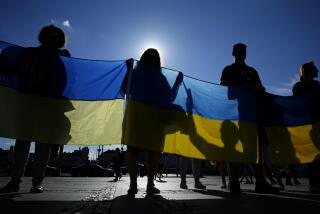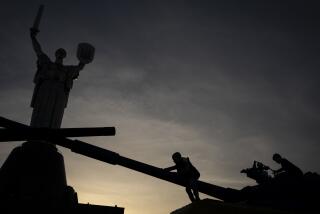Nationalities: Does Gorbachev Grasp the Urgency?
- Share via
SEATTLE — On Tuesday, President Mikhail S. Gorbachev convened a special two-day session of the Communist Party Central Committee to seek a solution for escalating ethnic and national strife. By his own admission, this threatens to rent the Soviet Union asunder. Unfortunately, an easy solution does not exist. Gorbachev’s dilemma is that the two most obvious solutions are likely to be equally unacceptable to him and the majority of the current Soviet leadership.
The first would require a radical restructuring of the Soviet state to accommodate a variety of nationalist demands--leading to the unraveling of the Soviet Union as we know it. For this is no mere ethnic ferment, but a nascent movement for national rights and emancipation from an oppressive centralized state--not unlike the modern liberation movements against Western colonial empires.
The second alternative is a violent suppression of the nationalist movements and restoration of central control. This may be successful in the short term. But in the longer term it is sure to guarantee more violence. In the meantime, glasnost, perestroika and any realistic chance to reform the ailing Soviet system would have to be scrapped--just as the Tien An Men massacre dealt a blow to Chinese reform that it will not recover from until the current leadership is gone.
Even a casual look at the Soviet Union reveals a crisis situation that no state can endure for long. Three Soviet republics are under de facto military rule. Soviet troops deployed in their own country for maintaining order in the past year probably exceed the numbers deployed in Afghanistan in any given year. And yet nationalist manifestations and ethnic conflict grow more pronounced.
Despite Moscow intervention, the Armenian-Azerbaijani conflict, for example, has worsened. A four-month old general strike by the population of the Armenian enclave has brought economic activity to a standstill. “Armenia,” declared party boss Surun G. Arutunyan at the plenum, “lives under conditions of blockade” and is nearing a “critical situation.” Mass demonstrations and strikes have become commonplace in Georgia, Azerbaijan, the Baltic republics, Moldavia and elsewhere.
Nationalist ferment has been marked by violence and bloodshed. Most disturbing is the mounting unrest among the 70 million Soviet Muslims. Recent ethnic clashes in Central Asia have claimed more than a hundred lives. In Uzbekistan, tens of thousands of well-organized and armed rioters demanded an Islamic republic.
More important for the longer term, popular movements are active in virtually every republic. Nationalist demands range from language rights and economic autonomy to outright secession. To some extent, these all present a challenge to the Soviet state. Moreover, nationalist elements are often able to co-opt local elites, and so pose a threat to the key instruments of central control. A growing number of republic party organizations have begun to push national economic and political agendas, seemingly oblivious of Moscow sensibilities and threatening to splinter the party along ethnic lines.
Several speakers at the plenum, for example, called for a restructuring of the Soviet Communist Party along federal lines. Gorbachev said this would result in its demise. Republic leaderships have also challenged the military by arguing for the restructuring of the army along national and territorial lines and have even demanded the right to control local units. Similar unheard-of demands are being made with respect to the KGB and the internal security apparatus. There is little doubt that if this trend continues, the current state structures will not last.
But why is this unprecedented nationalist turmoil happening, and why is it occurring when genuine liberalization and democratization of the system seem possible for the first time in Soviet history?
The answer is in the historical determinants of current problems. After taking control of a multinational empire, the Bolsheviks proclaimed national self-determination as the new state’s guiding principle. Yet when many of the former czarist possessions declared their desire for independence, they were reincorporated by force of arms. What followed was a long period of Stalinist oppression that aimed to extirpate national identity and create a unitary totalitarian state.
What Josef Stalin created under the guise of “Union of Soviet Socialist Republics” was perhaps the most centralized empire the world had seen. Yet unlike traditional empires, the nominal imperial nation, the Russians, became themselves a colonial subject and fared no better than the rest. The real beneficiaries were a multinational party bureaucracy and its power trappings--a gigantic military machine and an internal oppression apparatus.
Stalinism was followed by a more benign regime, but the imperial structures remained. Then came the “period of stagnation,” under Leonid I. Brezhnev, when the system began inexorably to decline. Political ossification, nepotism and corruption were the norm. Aware of communism’s failure as a vehicle of societal progress, the Soviet peoples went back to traditional values such as national identity, culture and religion.
This continuing national reawakening was unwittingly given a powerful impetus by Gorbachev’s policies. Contrary to Karl Marx, history teaches that revolutions occur not when people have “nothing to lose but their chains,” but when rising expectations are not satisfied. What is happening in the Soviet Union is the decolonization of the last empire. It is a historically inevitable process that cannot be arrested--only accommodated. What can save the Soviet Union is a prompt and radical restructuring into a federation of politically, culturally and economically autonomous states. The raison d’etat would be common economic interests.
Unfortunately, as of now, there is little evidence that Gorbachev is able or willing to pursue this course, or that he even understands the urgency of the problem. His policies have been tolerant of the nationalist movements--he has made important concessions, especially on the issue of economic autonomy. Yet he continues to praise the state’s Stalinist structures and appears ready to defend them. At the plenum, while acknowledging the legitimacy of many national grievances, he railed against “extremists” and repeated Stalinist cliches about the “voluntary” nature of belonging in the Soviet Union. This ambivalent centrist position is becoming untenable--it will neither prevent nationalists from seeking regional emancipation nor appease the advocates of a hard-line approach.
In fact, the latter may constitute a majority in the party hierarchy. Their opposition to Gorbachev’s tolerance is increasingly vocal. It is this part of the political spectrum that Gorbachev described in his plenum speech as those who “want to settle accounts.” But he is still in control and does not appear to be in any immediate danger. In fact, at the end of the plenum, he was able to purge from the Politburo two key people who probably advocated “settling of accounts.” Still, should the turmoil continue--as it is likely--the challenge from conservatives could become formidable.
Gorbachev thus is facing the most serious dilemma of his rule. The success of perestroika, as he has said, depends on solving the nationalist problem. Yet the answer is a radical restructuring that goes beyond his reforms. Should Gorbachev realize the inevitability of this and choose to steer the process rather than oppose it, he will end up in the history books as one of the century’s great visionaries. The alternative is chaos. His choice, to use the Marxist jargon, is to march with or against history. Today he can still make that choice; tomorrow it may be too late.
More to Read
Sign up for Essential California
The most important California stories and recommendations in your inbox every morning.
You may occasionally receive promotional content from the Los Angeles Times.













